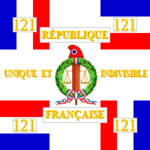Neogallican Civil War
| The Neogallican Civil War | |
| Date | 1792-1803 |
| Location | North America. Mainly in the then French Highlands. |
| Results | Stalemate (The territory passed into the hands of the North American League) |
| Combatants | |
 |

|
| Neofrancian & Native Allies |
French National Guard of Louisianna |
| Strength | |
| - | - |
| Famous Commanders | |
| - | - |
| Famous Battles | |
| - | - |
Also sometimes referred to as the "Neofrancian Rebellion" (in France and Louisianna) or the "War of Republican Aggression" (in New Francy), the Neogallican Civil War was a conflict in the late 18th century that opposed Republican and Royalist forces in the highlands of New France.
Background, France
The uprising of 1789 in France had brought to power a republican-leaning government who had set about reforming the kingdom. The king was originaly included in the new government (though without any real power) in a bid to assuage royalists both in the metropolitan and colonial lands. The king, although publicly accepting the new state of things, privately worked to undermine the republican government. After an attempt to escape was thwarted, the king was executed in 1792.
Background, New France
From 1789 to 1792, the colonies that formed New France had, like Metropolitan France, been reformed with new institutions and administrative divisions. While this was widely accepted in the departments that were formely part of Louisianna, the ex-Neofrancian departments saw sporadic acts of defiance against the new order. The two largest objects of contention were the requisition of harvest and livestock to feed the metropole and the dismissing of non-juring clerics (a priest or bishop who refused to accept the authority of the French government over that of the Pope).
The Civil War
When the news of the king's execution reached New France, some villages spontaneously rose up. Within a few weeks, the French-appointed adminstrators of New Francy had been chased off or killed by the local militias and a part of the colonial army which had rebelled against the republicans. A hastily convened Etats-Generals officialy broke relations with France and recalled the previous Intendant (who had remained on his lands in New Francy) as a rallying point for the local anti-republican forces. Of the other two former leaders of the province, the Legate immediatly gave his benediction to the return of the old order but the former Governor (who was known for some republican sympathy) had died in a hunting accident forcing the Intendant to take over his role as was costumary.
Some royalists in the former principality of Louisianna, upon hearing of the uprising, attempted a simlar coup. A few villages did managed to briefly make a stand but larger, better trained units of the local National Guard managed to quickly defeat them.
The highlands had not been touched much by the Revolution with most counters staying under the authority of the same trading companies as before. For this reason, and due to the large amounts of empty land, the highlands initialy proved to be a sort of neutral ground between the two factions. Small groups of people, aiming to escape either the republicans or the royalists, traveled through it toward presumed safety.
War party were sent by both factions to try and gain the allegiance of some of the local native tribes and, more importantly, to gain control of some of the Highlands' forts. Despite many battles and many reversals of fortune, neither the republicans nor the royalists managed to gain control of the territory and so no clear winner emerged from the war.
The Aftermath
After 10 years of on-and-off fighting and fearing that the perpetual conflict would hurt their revenue, a group of trading companies that operated in the Highlands banded together to try and negotiate a way out. They found the solution in the newly created North American League to which they requested admittance.
Although the NAL was interested in acquiring a land-bridge to the northernmost British colonies, the NAL government was weary of alienating another one of its neighbours (there still being a state of war between the League and Louisianna). The main sticking point with New Francy was that the Intendant felt uncomfortable with selling land which didn't belong by right to the Intendancy and even less so to a nation it perceived as its ancestral enemy.
The solution, suggested by the Highlands' cartel was to have a contract signed whereby New Francy simply renounced any territorial claims to the highlands and agreed to let a company administer the land. As this didn't mean dealing directly with any of the British nations, but only with the Hudson Bay Company, the deal was found to be acceptable. In exchange for its agreement, the Intendancy received from the HBC a piece of land to its northwest allowing it access to the Hudson bay and so to the lucrative seal hunting industry.
The Highlands were split up into territories that later became new provinces or were joined with existing ones (Ontario and Aquanishuonigy).
Louisianna for its part only renounced officialy its claim on the Highlands as part of the peace treaty following the War of 1828.